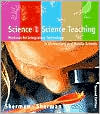List Books » Science and Science Teaching: Methods for Integrating Technology in Elementary and Middle Schools
Category Books
- Fiction Books & Literature
- Graphic Novels
- Horror
- Mystery & Crime
- Poetry
- Romance Books
- Science Fiction & Fantasy
- Thrillers
- Westerns
- Ages 0-2
- Ages 3-5
- Ages 6-8
- Ages 9-12
- Teens
- Children's Books
- African Americans
- Antiques & Collectibles
- Art, Architecture & Photography
- Bibles & Bible Studies
- Biography
- Business Books
- Christianity
- Computer Books & Technology Books
- Cookbooks, Food & Wine
- Crafts & Hobbies Books
- Education & Teaching
- Engineering
- Entertainment
- Foreign Languages
- Game Books
- Gay & Lesbian
- Health Books, Diet & Fitness Books
- History
- Home & Garden
- Humor Books
- Judaism & Judaica
- Law
- Medical Books
- New Age & Spirituality
- Nonfiction
- Parenting & Family
- Pets
- Philosophy
- Political Books & Current Events Books
- Psychology & Psychotherapy
- Reference
- Religion Books
- Science & Nature
- Self Improvement
- Sex & Relationships
- Social Sciences
- Sports & Adventure
- Study Guides & Test Prep
- Travel
- True Crime
- Weddings
- Women's Studies
Science and Science Teaching: Methods for Integrating Technology in Elementary and Middle Schools » (2nd Edition)

Authors: Sharon Sherman, Robert Sherman
ISBN-13: 9780618318070, ISBN-10: 0618318070
Format: Paperback
Publisher: Cengage Learning
Date Published: July 2003
Edition: 2nd Edition
Author Biography: Sharon Sherman
Book Synopsis
This core text for the K-8 methods course in science is a practical guide to teaching science in inquiry-centered and standards-based classrooms. Its inclusive coverage of the major domains of science includes examples from the studies of life, physics, earth, space, and environment. This edition integrates technology thoroughly with science content, instructional methods, and cues to monitoring student development.
Table of Contents
Note: Each
Chapter contains a Summary and Key Terms. I. Background Knowledge for Science Teaching
1.Science and Technology in the Classroom What Is Science? What Is Technology, and Why Use It? What Influences Science Teaching Today?
2.Instructional Technology Basics What Are the Standards That Guide Instructional Technology Education? Basics of the Internet More Computer Basics The State of Technology Resources in Schools How Do Teachers Use Instructional Technology in Science Teaching?
3.How Children Learn Children Construct Knowledge The Cognitive Growth of the Child Prior Knowledge, Misconceptions, and Conceptual Change Developmentally Appropriate Technology Internet Safety and Appropriate Behavior
4.Engaging in Inquiry and Discovery Inquiry-Based Instruction Bringing Inquiry-Based Instruction to Your Classroom Techniques for Inquiry-Based Instruction Your Development as an Elementary Science Teacher
5.Using Science Processes to Guide Inquiry A Pumpkin Investigation The Process Skills Using the Process Skills in Your Classroom Constructing Knowledge II. Instruction and Assessment in a Standards-Based Science Classroom
6.Planning Lessons and Designing Assessments What Does a Good Science
Lesson Plan Contain? Assessing and Evaluating Student Learning Linking Instruction, Assessment, and Child Development Understanding and Using Performance Assessment
7.Science in the Diverse Classroom Diversity in Classrooms Constructing Inquiry-Based Lessons for the Diverse Science Classroom Addressing the Needs of Students with Learning Disabilities Addressing the Needs of Gifted Students
8.Encouraging Collaboration and Cooperation What Is CollaborativeInquiry? Collaborative Projects for Preschool and Primary Grades Collaborative Projects for Upper-Elementary Grades Collaborative Projects for Middle School Developing Your Own Collaborative Project Cooperative Learning in the Science Classroom Characteristics of Cooperative-Learning Activities Classroom Management for Cooperative Learning Cooperative Strategies
9.Making Real-World Connections: Real-Time Data and Critters in the Classroom What Are Real-Time Data? Using Real-Time Data in the Classroom Studying Animals in Real Time Managing Critters in the Classroom Plants in the Classroom Using Real-World Connections in Extended Inquiry
10.Strategies for Project-Based Learning Project-Based Learning Planning a Project Using Sensors and Probes for Data Collection Analyzing Results: Modeling, Simulation, and Visualization More Ideas for Designing Projects
11.Strategies for Design-Based Learning The Nature of Technology and Technological Problem Solving The Design Loop Implementing the Design Loop Learning About Simple Machines Designing Weather Instruments Using Simple Machines
12.Science Across the Curriculum Strategies for Integrating Science Across the Curriculum Creating Interdisciplinary Thematic Units Preparing to Use an Integrated Approach to Science Teaching Teacher's Handy Reference Glossary References
Index
Subjects
 Teaching & Teacher Training
Teaching & Teacher Training  Educational Aspects of Technology
Educational Aspects of TechnologyEducation & Teaching
 Teaching & Teacher Training
Teaching & Teacher Training  Teaching - Science & Technology
Teaching - Science & TechnologyEngineering
 Social & Cultural Aspects of Technology
Social & Cultural Aspects of Technology  Educational Aspects of Technology
Educational Aspects of TechnologyScience & Nature
 Reference & Textbooks
Reference & Textbooks  Study & Teaching of Science
Study & Teaching of ScienceScience & Nature
 All Science & Nature
All Science & Nature  Science Reference
Science ReferenceNonfiction
 Science & Nature
Science & Nature  Reference & Textbooks
Reference & TextbooksNonfiction
 Science & Nature
Science & Nature  All Science & Nature
All Science & Nature
